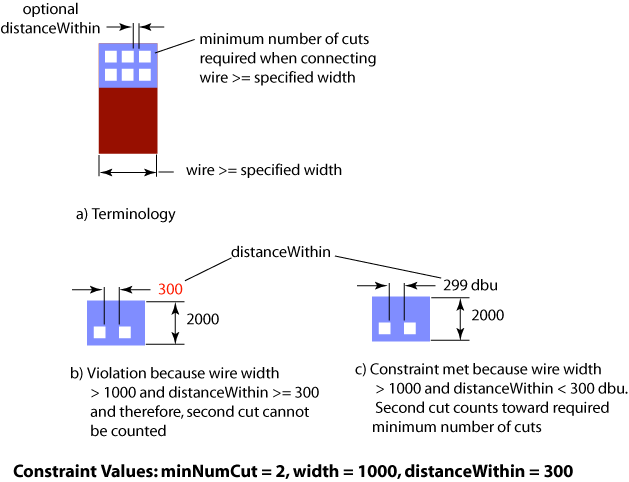 |
 |
 |
||||||
The built-in oacMinNumCut layer constraint specifies the number of cuts a via object or via instance must have when connecting between two wide wire shapes or when connecting a wide shape to a pin. An optional parameter can be used to define the distance at which additional cut shapes cannot be counted for meeting this constraint.
The oacMinNumCut constraint is specified for cut layers only.
| Constraint type: | oaLayerConstraint |
| Value types: | oaInt1DTblValue |
| Database types: | oaDesign, oaTech |
| Object types: | oaAppObject |
The following value types are supported by this constraint:
oacMinNumCut constraints have an oaInt1DTblValue in which the lookup key ("width") is the width of the connecting metal and the value is the number of cuts required.
Units: DBU
The following parameters are supported by this constraint:
| Name | Value Type | Units | Default | Description | ||||||||
|---|---|---|---|---|---|---|---|---|---|---|---|---|
| oaDistanceWithin oacDistanceWithinConstraintParamType |
oaIntValue | DBU | None |
The optional distanceWithin parameter is an oaIntValue represented by oacDistanceWithinConstraintParamType to specify the distance at which cuts cannot be counted toward the minimum number of required cuts. Cuts must be closer than the specified distance in order to be counted. |
||||||||
| neighborLayerMetal oacNeighborLayerMetalConstraintParamType |
oaIntValue | Enum | UpperLowerLayerMetalType |
This parameter specifies the cut layers to which this constraint applies. If this parameter is not specified, the constraint applies to both upper and lower metal layers. This parameter is represented by an oaNeighborLayerMetalType enumeration:
|

Usually wide wires carry more current. If you are changing layers between two wide pieces of geometry, you need sufficient vias to carry an equivalent amount of current. Using several via cuts, instead of just one, also increases reliability. Air pockets can be created in the metal during processing, and over time, these pockets tend to move toward the vias. While an open results if the pocket moves under one via, if the first via stops the pocket from drifting, having additional vias allows the circuit to continue operating.
Copyright 2002 - 2010 Cadence Design Systems, Inc.
All rights reserved.